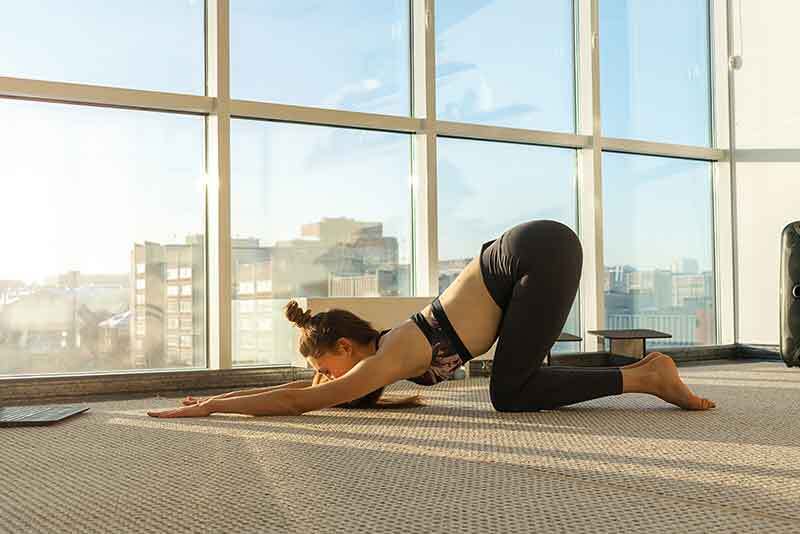In this fast-paced life, feelings of anxiety and low mood have become constant companions, whispering their presence in the midst of our daily challenges. It’s common to feel nervous before a big event or want to stay in bed when we’re feeling low. But if these feelings stick around for a long time, they might turn into something more serious, like anxiety or depression.
Thankfully, the ancient practice of yoga offers a sanctuary of peace and healing. In this article, we’ll explore how yoga helps with your mental wellbeing. We’ll also discuss some specific yoga asanas for anxiety and depression and their benefits.
How Yoga Helps in Dealing with Anxiety and Depression
Yoga serves as a holistic approach to managing anxiety and depression. It includes a combination of gentle movement (asana), controlled breathing (pranayama), and focused meditation. This holistic practice activates the parasympathetic nervous system, which further induces a state of rest and digestion. This further aids people in maintaining calmness amidst anxiety and depression challenges.
Yoga is good for both body and mind, and it also makes you healthier and happier. It helps contribute to mental balance, offering individuals a comprehensive tool for emotional resilience.
A study found that people taking care of those with dementia felt less sad and anxious after a six-session yoga-meditation program. The study showed that caregivers felt more sure, suggesting that yoga could help with mental health in certain cases.
| Suggest read: Panic Attack Vs Anxiety Attack
Yoga Poses for Anxiety and Depression Relief:
1. Extended Puppy Pose (Uttana Shishosana):

Extended puppy pose is a gentle yoga pose that combines a soothing forward stretch with a grounding posture. This further offers relief to the spine and shoulders.
How to Practice:
- Begin in a tabletop position with your wrists directly under your shoulders and your knees under your hips.
- Extend your hands forward a few inches, reaching your arms out as far as comfortable.
- Slowly sink your buttocks down towards your heels, creating a gentle stretch through your spine.
- Press into your hands, engaging your arm muscles, and keep your elbows lifted to avoid collapsing.
- Gently lower your forehead to the floor, allowing your neck to relax.
- Feel the opening and softening of your chest during this pose, inviting a sense of release.
- Hold the pose for up to two minutes, focusing on your breath and allowing any tension to dissipate.
Benefits: The Extended Puppy Pose in yoga has several benefits. It helps make your back and shoulders more flexible. Additionally, it also makes you feel relaxed.
2. Downward Facing Dog Pose (Adho Mukha Svanasana):

Also known as Adho Mukha Svanasana, involves the inversion of the body, encouraging blood flow to the brain. This, in turn, plays a pivotal role in reducing anxiety levels.
How to Practice:
- Start on your hands and knees, with your wrists under your shoulders and your knees under your hips.
- Lift your hips towards the ceiling, straighten your legs, and create an inverted V shape with your body.
- Place your hands on the mat, making sure they are shoulder-width apart.
- Experience the stretch along your spine and the back of your legs.
- Maintain the pose, allowing your head to hang freely, for up to one minute.
Benefits: Downward Dog energies the body, simultaneously releasing tension in the shoulders and promoting a sense of rejuvenation.
| Suggest read: Pranayama For Anxiety And Depression
3. Upward Facing Dog Pose (Urdhva Mukha Svanasana):

The Upward Facing Dog Pose is a backbend that opens the chest, inviting positivity into one’s mental space. It not only improves your mood but also contributes to the strengthening of the spine and core.
How to Practice:
- Begin by lying on your stomach with your legs extended and the tops of your feet on the floor.
- Press your hands into the mat, raising your chest and looking upward.
- Maintain straight legs, with the tops of your feet resting on the floor.
- Experience the opening in your chest and the stretch along your spine.
- Maintain the position for about 30 seconds, taking deep breaths.
Benefits: It uplifts the mood, counteracting the hunched posture associated with stress.
4. Shoulder Stand (Sarvangasana):

Sarvangasana is an inversion yoga pose that stimulates the thyroid gland. This stimulation also plays a crucial role in regulating mood and energy levels by releasing stress. This makes it a powerful yoga asana for anxiety and depression.
How to Practice:
- Lie on your back and lift your legs overhead, supporting your lower back with your hands.
- Ensure that your legs are straight, pointing towards the ceiling.
- Engage your core and press your elbows into the ground.
- Hold the pose for up to two minutes, focusing on steady breathing.
Benefits: This inversion stimulates the thyroid gland, fostering balance and reducing mental fatigue.
| Suggest read: Benefits Of Yoga For Students
5. Standing Forward Fold (Uttanasana):

Standing Forward Fold, involves a deep forward bend that releases stress and tension along the spine.
How to Practice:
- Stand with your feet hip-width apart.
- Hinge at your hips, bringing your torso towards your thighs.
- Allow your head to hang freely, and let your arms dangle or grasp opposite elbows.
- Feel the stretch in your hamstrings and the release in your spine.
- Hold the pose for up to one minute, breathing deeply.
Benefits: Eases tension in the spine, allowing for a gentle surrender to the present moment.
6. Child Pose (Balasana):

Child Pose is the best beginner yoga for anxiety and depression. It helps relax the body and mind.
How to Practice:
- Kneel on the mat with your big toes touching and your knees apart.
- Sit back on your heels, extending your arms forward or alongside your body.
- Rest your forehead on the mat and allow your chest to soften.
- Breathe deeply into your back, holding the pose for up to two minutes.
Benefits: A relaxing pose, Balasana releases tension in the back and shoulders, promoting a sense of security.
| Suggest read: Simple Breathing Exercises For Stress And Anxiety
7. Reclining Bound Angle Pose (Supta Baddha Konasana):

Reclining Bound Angle Pose is a relaxing yoga depression and anxiety cure. Additionally, this relaxing pose opens your hips and relieves the tension. Adding a reclining bound angle pose to your routine can help relieve anxiety and depression.
How to practice:
- Lie on your back.
- Bring the soles of your feet together, letting your knees fall outward.
- Find a comfortable arm position: hands on your belly, arms open to the sides, or resting by your sides with palms facing up.
- Close your eyes, take slow, deep breaths, and allow your body to relax into the pose.
- Hold for 5 to 10 minutes, focusing on your breath and releasing tension.
- To exit, engage your abdominal muscles, bring your knees together, and gently roll to one side before sitting up.
Benefits: Reclining Bound Angle Pose is a restful posture that opens the hips, promotes relaxation, and soothes anxiety.
8. Corpse Pose (Savasana):

Corpse pose is generally marked as the end of a yoga session. Savasana helps relax the body and mind, reducing anxiety and stress for better well-being.
How to Practice:
- Lie on your back with your legs extended and your arms by your sides.
- Close your eyes and focus on your breath, allowing your body to completely relax.
- Let go of any tension in your muscles and surrender to the floor.
- Hold the pose for up to five minutes, embracing a state of deep relaxation.
Benefits: Savasana helps you relax deeply, letting go of emotions and feeling refreshed. This is highly beneficial if you are dealing with depressive disorders.
| Suggest read: Simple Ways To Relieve Stress And Anxiety
Holistic Approaches Beyond Asanas
Yoga is more than just physical poses; it’s a way of living that promotes mental and emotional well-being. Yama and Niyama are two sets of guidelines that help us live in a way that reduces stress and anxiety.
Yama focuses on how we interact with the world around us. It reminds us to be kind, truthful, and content with ourselves and others.
Niyama focuses on how we treat ourselves. It encourages us to be clean, disciplined, and accepting of what we cannot control. Practicing Yama and Niyama are the best philosophical aspects of yoga to get rid of anxiety and depression.
Here are some specific ways that Yama and Niyama can help with anxiety:
- Kindness (Ahimsa): When we are kind to others, we feel good about ourselves. This can help to reduce anxiety and boost our mood.
- Truthfulness (Satya): When we are truthful, we don’t have to worry about being caught in a lie.
- Contentment (Santosha): When we are content with what we have, we don’t feel the need to compare ourselves to others. This can reduce the feeling of jealousy and insecurity.
- Discipline (Tapas): When we are disciplined, we have more control over our lives. This can reduce stress and anxiety.
- Surrender (Ishvara Pranidhana): When we accept what we cannot control, we reduce our frustration and anxiety. This can be especially helpful for people who worry about the future.
If you are struggling with anxiety, incorporating Yama and Niyama into your life can be a helpful way to manage your symptoms.
Pranayama and Meditation: Breath Control and Mindfulness
Breath control, or pranayama, and meditation are powerful tools for managing anxiety and depression. Also, breathing exercises like Nadi Shodhana (alternate nostril breathing) and Kapalbhati (skull-shining breath) help calm the nervous system. This further helps relieve symptoms of depression.
Check out the best breathing exercises that will help relieve anxiety and depression-
Meditation is an important part of yoga that helps you stay focused and aware of yourself. Regular meditation practice helps reduce the symptoms of anxiety and depression. This further helps in promoting emotional well-being.
Nurture Your Mental Well-being through Nutrition and Lifestyle Choices
- Mindful and Balanced Nutrition:
A healthy diet is crucial for good mental health. Studies show a strong link between what we eat and how we feel. Eating a balanced diet full of nutrients supports overall well-being. Foods high in omega-3 fatty acids, fruits, vegetables, and whole grains give us essential vitamins and minerals to support our mental health. On the other hand, over consumption of processed foods, sugars, and caffeine can cause mood swings and worsen the symptoms of anxiety and depression.
Check out – https://www.youtube.com/@yuvaapkitchen/ Channels for nutritious recipes
- Prioritize Your Sleep
Prioritize getting enough sleep each night to allow your body and mind to rest and recharge. Try to aim for 7-8 hours of quality sleep each night if you are dealing with anxiety disorders.
- Seek Professional Help
If you’re feeling very worried or sad and it’s making it difficult for you to do your daily activities, it’s a good idea to talk to someone who can help. Additionally, a therapist or counselor is someone who can give you personalized advice and support. They’re like a professional guide that will help you feel better by navigating all the triggers of your anxiety with you.
Practicing these yoga poses to ease stress and anxiety isn’t just about moving your body; it’s also about connecting your mind and body for overall well-being. By including yoga for anxiety and stress relief into your routine, you can ease anxiety and depression. Moreover, trying out different ways, not just poses to relieve stress, can make your journey of change even better.
Remember, if you’re dealing with serious anxiety or depression, talk to a professional. Also, take things one step at a time, let these practices work their magic, and bring calm and balance to your life.
References:
- https://www.ncbi.nlm.nih.gov/pmc/articles/PMC5843960/
- https://www.ncbi.nlm.nih.gov/pmc/articles/PMC3768217/

Mr. Vijay Kumar Pandey is an eminent Yoga teacher with 15 years of experience. He excelled himself in Iyengar Yoga under the guidance of revered master BKS Iyengar Read More


